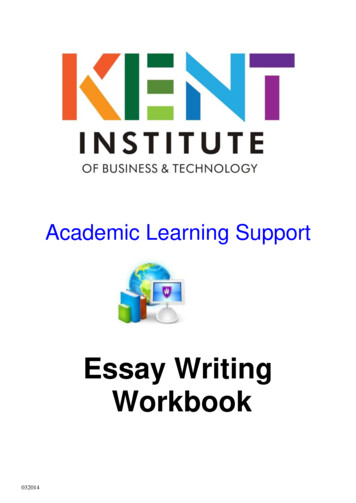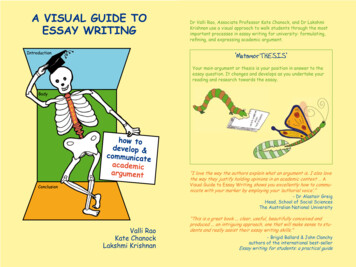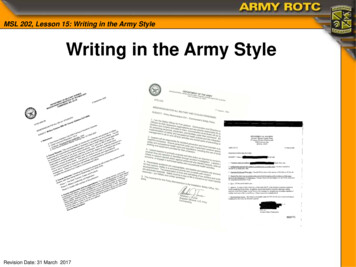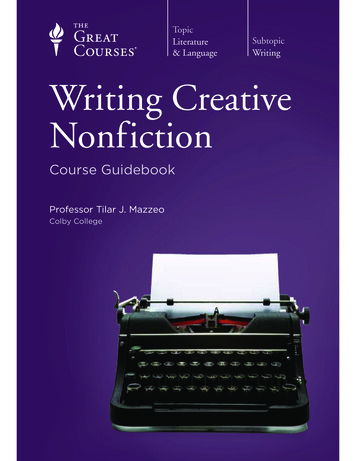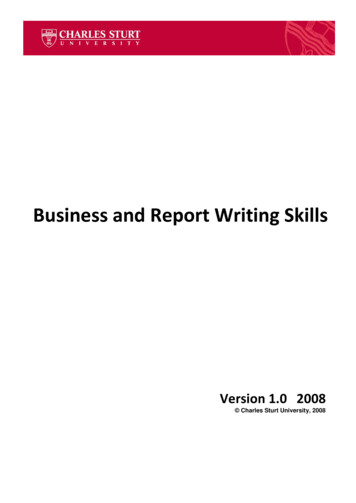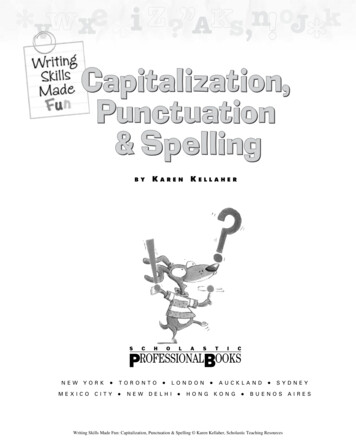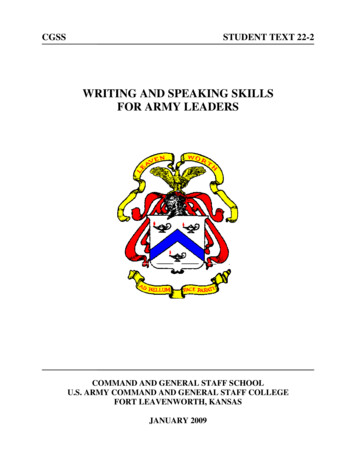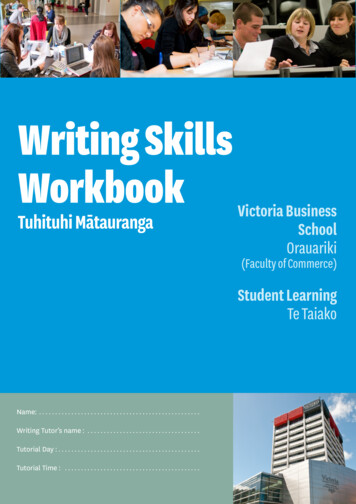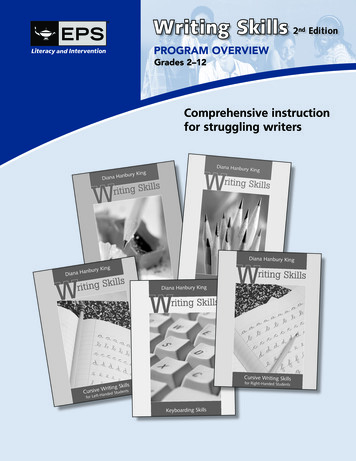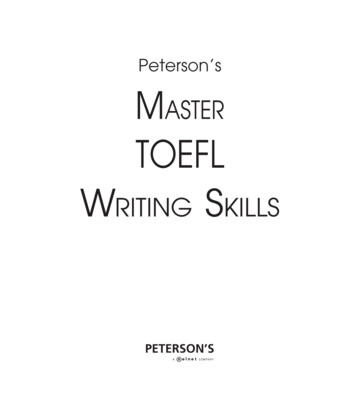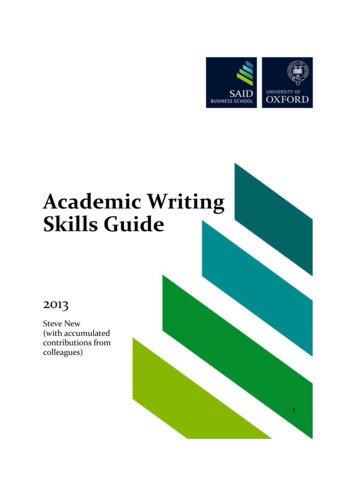
Transcription
Academic WritingSkills Guide2013Steve New(with accumulatedcontributions fromcolleagues)
1. IntroductionMany people find essay writing extremely difficult; very few find it easy to do well. These notesare designed to give some useful tips and to help students understand what is expected inacademic writing.2. BackgroundThere is more to essay writing than putting words on paper. The form of writing that we nowunderstand as acceptable for essays or academic papers has developed over several hundredyears; there are certain conventions to follow, and these differ markedly from, say, journalism,business reports or fiction. The communication (and, or course, steady evolution) of theseconventions is a major part of universities' role in the reproduction of culture. The educationalprocess is not just about the transmission of information and knowledge, but also aboutinitiating students in a particular way of thinking and communicating.Learning how to write according to academic conventions is important for at least tworeasons. Firstly, the skills are needed to participate in the educational process for essays andexaminations questions. Secondly, in later life, many people are required both to produce andinterpret written work that follows these conventions.3. Some MisconceptionsUnfortunately, many myths exist about the writing process, and some of these have seriousconsequences. Firstly, many people think that others find it easier than they do. In fact,nearly everybody finds academic writing extremely difficult; some find it highly stressful.Becker (1986) discusses how some people feel great shame and inadequacy when they sitdown to write, wrongly thinking that they ought to be able to produce beautiful and cogentprose instantly. This may be true of great authors, and a very small number of highly giftedacademics; for most of us, writing is not easy, and usually involves revisions and re-writes.Some people develop highly complex avoidance rituals (such as obsessively sharpening pencilsor tidying their workspace) that they use to delay the start of the dreaded process.A second misconception is that the purpose of an essay or article is just to recapitulate aseries of facts and definitions. This is the approach used at many schools. Academic writing,on the other hand, seeks to make a point or take some position regarding an existing debate.Often this is to present some angle or 'spin' on a particular argument. Essays thatmechanically reproduce information culled from other sources are dull to read and score lowmarks. Much better are essays which show evidence of the writer's own thoughts on thesubject and which show that the source material has been read critically. This means that thebest essays are the ones that tackle - explicitly or implicitly - the questions: “Why is thisinteresting?”; “What is the point here?”; “How do they know that?”A third misconception is that good writing is necessarily flowery and uses many sophisticatedallusions. This is rarely the case in the social sciences, where clarity and economy are virtues.Academic writing should be easy to read and unpretentious. Finally, sometimes writing essaysis dismissed as being an artificial exercise of little relevance to the real world; on the contrary,developing a robust argument and accurately expressing ideas are valuable practical skills.4. Writing and ThinkingThere is a great deal of practical advice around about the precise use of words and crafting ofprose (some of this may be found in the books listed below). However, the starting point forany piece of academic writing is its intellectual content. It is possible (though not advisable) towrite essays without reference to external sources; no amount of reading, however, cancompensate for a lack of thought. The starting point of all good essays is an argument or aquestion.
t-related payesty(WagesfetaxsaRertMoneyEffonusBothT i psMmresueaaltPerformputheesBasicPayoutenMoOtBe hernefitsQuality oflifelionatvitformainformalWealthinput}The key problem is to decide what needs to be said, the overall shape of the argument and theway in which the component parts will link together. Many people find it helpful to start theprocess by producing a list of headings, or to construct schematic diagrams with boxes andarrows. One method which some find helpful is the idea of ‘patterns’ as developed by Buznan(1974) - see Figure One (Buznan claims this can reduce the time it takes to write an essay bytwo-thirds). Others write down key points on Post-It notes and rearrange ideas on aconvenient wall, or make use of the automatic outlining facilities available in most modernword processors.sDifferenuniontiaslsFigure 1: An Example 'Pattern' for an essay on the determination of wagesSome techniques focus on the hierarchies within the text, and sketch out the structure as inFigure Two. Whatever technique (if any) is used, there is no escaping the need for intellectualeffort; the quality of an essay is highly dependent on the thought that is invested at this stage.Some key questions are: What is the purpose of the essay?What are the key facts?How do they connect together?What is the conclusion?What is the logical flow between the different parts of the argument?Answering these questions can help the writer craft an argument that has a cleardevelopment, and an identifiable beginning, middle and end.2
Figure 2: An approach to setting out the logical flow of an essay5. Writing with a purposeDeveloping a particular angle or a ‘spin’ generally requires a combination of imagination andmastery of the subject. The writer needs to understand the material sufficiently well so as tobe able to persuade the reader that what he or she has to say is both convincing andinteresting. The challenge is to present an argument which is true and non-obvious. Goodessays demonstrate efforts by the writer on both of these fronts: the reader needs to know notjust that something is or is not the case, but why it is interesting. Work which does this iseasier to read, and - with practice - easier to write. Some examples of rhetorical structuresthat can be used to help cast an essay in this mould are: One might think that X would behave in the same way as Y, but in fact they are different.One might think that X and Y are fundamentally different, but in fact they are the same.Everyone has neglected factor Z, but it is actually very important.Everyone thinks Z is very important, but in fact it is irrelevant.X is assumed to have superseded Y, but X is really just Y with a new label.Despite the importance of such frameworks, it is worth noting the danger of the ‘straw man’argument; if you are going to argue that fact X disproves Y’s theory of Z, one should be able toshow that Y really does think that about Z, and that you have done justice to Y’s position.6. Answering the QuestionWhether an essay is written to address a set question, or a question raised by the writer in thedevelopment of the rhetorical framework, it is always important to answer the question. Thismay seem too obvious to state, but most academics have long experience of reading essays(and, indeed, examination scripts) that fail to do what is requested. Failures seem to arisefrom two main problems: not reading the question with sufficient care, and simply gettingcarried away.3
Care in reading the question cannot be over-emphasised. This should be done several times; itmay be helpful to underline or highlight the key words and phrases. Special attention shouldbe paid to the instructive words (e.g. Account for; Assess; Criticise; Give an account of;Examine; Compare and contrast; Discuss; Illustrate; Evaluate; Demonstrate; How far./Towhat extent?; Trace). These all have distinctive meanings, and will demand differentresponses. A common error, for example, is to respond with two unconnected descriptions to arequest for a comparison.Simply forgetting to answer the problem (in all the excitement of the process of writing) is alsocommon. The best safeguard against this is to ensure that essays end with a clear conclusion.7. Logic and the Pattern of ArgumentAn essential part of answering a question is to ensure that you are making a clear argument.This can only be done effectively if you think about the argument you are going to make beforeyou start writing your essay. A very common fault is for students to insert information fromthe readings (all too frequently organised by author) and only to consider how this informationmight interrelate or assist in answering the question when it comes to time to conclude theessay. Avoid making this mistake. Think carefully about what argument you want to makeand structure the material you have to assist you in doing so.One of the key challenges in developing an argument is making convincing logical connectionsbetween the separate points. Three useful ways to clarify the logic of an argument are:Thesis/Antithesis/SynthesisThis works by contrasting one thing with its logical opposite, and using the tension(sometimes referred to in terms of the ‘dialectic’) between the two to generate somekind of third option. Examples of this kind of device would be an assessment ofmarkets and hierarchies which led to the evaluation of hybrid forms of economicorganisation, and an evaluation of collectivism and individualism which led to adiscussion of democratic liberalism.Proposition - proofAnother style of argument is the presentation of a statement with the evidence thatsupports it (e.g. proposition: even in modern society, there is a gendered division oflabour; proof: statistics which show that men do far less housework than women.) Thisstraightforward pattern is undermined with surprising regularity by arguments thatcontain many propositions offered without support, and lots of evidence which fails toconnect with any proposition.Disproof by counter-example and Popperian falsificationismA useful technique is to use a single case that disproves a general theory. It isimpossible to prove any positive theory to be universally true: to check the statement“All swans are white” one would have to check all swans. The statement can beinstantly disproved, however, by finding a single black swan. This means that a goodway of evaluating theories in social science is to look for cases where the theory mightbreak down. Unfortunately, many theories in social science are couched in vagueterms, and in the language of tendencies rather than causes, so it is very difficult toshow they are wrong by counter-example.On the other hand, the philosopher Karl Popper has eloquently argued that theorieswhich are devised in such a way to make them fundamentally immune from beingfalsified by evidence should not be counted as being ‘scientific’. In other words, an ideais only scientific if, among other things, it could potentially be shown to be wrong buthas not been so far. Your essay might not only question the truth of a theory, but alsoits ‘scientific’ status.4
The ‘Transcendental’ QuestionThis is nothing to do with meditation; it refers to a type of reasoning which says, “whatmust be true for X to be the case?” The philosopher Roy Bhaskar maintains that thisis one of the fundamental scientific questions, and that it is the basis of mostreasoning in experimental sciences. An alternative formulation is: what is the simplestand most elegant explanation of the phenomenon in question? What is the mostconvincing story out of all the possible stories that could be told?The Deconstuctionist QuestionThis approach starts with the cynical questions: If X is held to be true, who stands togain? Whose agenda is being served here? Lots of elements of management andeconomic thinking sound pristinely abstract and delightfully logical, but in fact maysupport particular constituencies (for example, rhetoric about the importance of‘leadership’ may be rather convenient for reinforcing the position of those already inpowerful positions in an organisation). Many students find that this approach is one ofthe most intellectually exciting strategies in formulating their ideas, not least becauseone can draw directly on ideas from political philosophy and interesting writers likeMichel Foucault. However, it requires great care to avoid this approach degeneratinginto simplistic ‘conspiracy theories’ – so it needs to be applied with care and attentionto detail.8. Using materialEssay writing involves preparation: perhaps the most significant element is doing thenecessary reading. There is generally no limit to the extent of the material that could be read.This means that you need to prioritise your work, develop skills for dealing with large volumesof material, and manage your time effectively.8.1 Reading SkillsThe vast quantities of information that are available mean that it is important that you readas intelligently as possible. For most social science literature, this means ‘skim reading’ adocument or book before reading line-by-line. It is advisable to pay particular attention to theintroduction and conclusion to articles or chapters to understand the thrust of the argumentthat is being made. Having a feel for where the argument is going makes it easier tounderstand when you read it carefully. It can also help you identify those parts which meritdetailed analysis and those which can be left.8.2 Note TakingWhen reading, it is always useful to make notes (even if they are rather sketchy) and to keep asystematic record of the full reference (see below). This saves a great deal of time re-checkingbibliographic details later. However, you need to think carefully about your approach to notetaking. Many students start with the habit of making extensive notes on everything they read.However, this is usually impracticable. Instead, you should focus on the principal argumentsthat the author is making, together with the main supporting evidence. You may well find itbest to read the whole article or chapter first before making notes: this allows you tounderstand more fully the argument and to concentrate your notes on those. You should alsobe aware whether you are drawing direct quotes from the material, paraphrasing it, orsummarising the argument in your own words.8.3 PlagiarismPlagiarism is the presentation of someone else’s work as your own, and includes copying partor all of someone else’s essay, or simply copying material from a published source.You should never simply copy material.5
Note that changing the occasional word or grammatical construction is not acceptable, and isno substitute for formulating your own thoughts. It is theft. Plagiarism not only breaksacademic convention, but also is treated as an offence within universities and may lead todisciplinary action.The University defines plagiarism as:othe copying or paraphrasing of other people’s work or ideas into your own work without fullacknowledgement. All published and unpublished material, whether in manuscript, printedor electronic form, is covered under this definition.oCollusion is another form of plagiarism involving the unauthorized collaboration of students(or others) in a piece of work.Plagiarism can take many forms.oThese include verbatim quotations of other people’s work without due referencing;oParaphrasing and altering a few words, again without due referencing (so that you give theimpression that the ideas or arguments are your own);oCutting and pasting from the internet;oCollusion;oInaccurate citation;oFailure to acknowledge the assistance of others;oCopying from the essays written by other students (or professional agencies)An Example:Source Text“In order to benefit from the cost advantages of these new, high-volume technologies orproduction, entrepreneurs had to make three sets of interrelated investments. The first wasan investment in production facilities large enough to exploit a technology’s potentialeconomies of scale or scope. The second was an investment in a national and internationalmarketing and distributing network, so that the volume of sales might keep pace with the newvolume of production. Finally, to benefit fully from these two kinds of investment theentrepreneurs also had to invest in management: they had to recruit and train managers notonly to administer the enlarged facilities and increased personnel in both production anddistribution, but also to monitor and coordinate those two basic functional activities and toplan and allocate resources for future production and distribution. It was this three-prongedinvestment in production, distribution, and management that brought the modern industrialenterprise into being.”(Chandler, Alfred D. 1990. Scale and Scope: The Dynamics of Industrial Capitalism, p.8)Some Examples of Plagiarism1. Entrepreneurs had to make three interrelated sets of investments. It was the threepronged investment in production, distribution, and management that brought themodern industrial enterprise into being. Managers had to allocate resources for futureproduction and distribution.(This includes verbatim quotations with no acknowledgement that they are such andno reference to Chandler.)2. The creation of the modern industrial enterprise resulted from three related6
investments which entrepreneurs need to make to gain cost advantages. These werein production facilities, distribution networks and managerial capability.(The paraphrasing still requires careful referencing to Chandler.)3. Gaining the benefit of cost advantages from new technologies was key to thedevelopment of the modern business organisation. Chandler argues that threeinterrelated investments were required: in production, distribution and management.(By placing Chandler only in the second sentence, the impression is given that the firstsentence is the author’s own argument. In fact, all of this material is drawn fromChandler and needs to be referenced accordingly.)8.4 ReferencesWhen using any source of information in preparing your work, you should give clearreferences, listed at the end. For most academic writing, it is not acceptable to rely on abibliography (although in some cases you may wish to include one): you must provide a linkbetween what you say and from where the material is drawn. There are a number of commonconventions for this. If referencing material from journals, then volume number, issue number(if there is one), date and page numbers are essential. Books should be given with their date,publisher and place of publication. If you are referring to an item with more than two authors,you may use the form ‘Bloggs et al.’ in the text, but the reference list should give all theauthors, with initials. Appendix One gives you an exercise which should help you get the hangof this.Two possible formats for references are given below. The first (which is commonly termed‘Harvard style’) includes the names of the author(s) in the text itself, together with the date. Analphabetical list of references (by author surname) is then included after the main text. This isby far the best method of referencing for essays, because it is easy to use and check, and –more importantly – it makes it easy to engage critically with the sources being used.Example 1Perry (2001) claims that all major car manufacturers have now adopted leanproduction. Three main criticisms can be made of this position. Firstly, Perry’sclaim is not supported by systematic data, but relies on an incomplete set ofrather lame anecdotes. Secondly, he does not distinguish between the rhetoricof ‘lean’ and actual practice. As Hodge (2002) points out, firms have anincentive to present themselves as being in step with accepted notions of bestpractice, especially to key audiences (for example, industry analysts andjournalists – see Huckelthaw and Prentis 1984). Furthermore, individualmanagers also have incentives to present their actions as being consistent withmanagement fads (a point also made by Stevens and Chutzpah 1992). Thirdly,as McWilliams (1998) points out, there is no clear empirical measure of whatconstitutes ‘lean’ other than comparison with other, worse performingcompanies. As McWilliams has it: “If everyone is lean, no-one is lean!” (p.277).ReferencesHodge, L. (2002) “How can we know what firms are doing?” The Governance Report. May.Available on-line at www.Hodgereports.com/Mayrep.htm.Huckelthaw. P.J. jnr and Prentis, K.(1984) “Why managers lie to everyone – includingthemselves” International Journal of Management Mendacity 26:3 pp.3-12.McWilliams, H.K. (1998) “Lean production: what a load of old tripe.” In: ManagementParadigms and Fantasies, Second Edition. (Grosz, H. and Fingletoff, D., eds.), Spitfire7
Publications, San Francisco. pp.255-288.Perry, J.H. (1991) “Lean production: the conqueror of the world”. Production and QualityManagement Journal. 32:3. pp.270-279.Stevens H. and Chutzpah H. (1992) Management Motivations. The Free Press, New York.An alternative is to use footnotes or endnotes:Example 2Some consultants have claimed that Just-in-Time (JIT) without Electronic DataInterchange (EDI) will normally raise costs, due to increased paperwork1.However, this does not appear to be the case for the Japanese originators of thetechnique2.1.2."EDI is Just-in-time" Report in Manufacturing Systems, February 1990, p.8.Ohno. T. Toyota Production System: beyond large scale production. ProductivityPress, Cambridge, MA (1988).This second approach is not recommended for essays. You will often use your essays forrevision and it this style makes it easy to pay insufficient attention to where the argumentsare drawn from.Remember that it is not only the arguments of other authors which require references. As arule, whenever you state something as a fact it should be supported by a reference whichsupports that. This could be the source of the data you have cited or it could a reference tothe authority from which you have drawn the fact. This latter use can be a useful shorthand.However, remember that you should be considering all information critically.There are many conventions for the precise order and format of names and dates and otherbibliographic information for the list of references at the end of an essay. Whatever system isused, it is important that it includes all the required information, and is consistent. Beingconsistent makes it easier to check that you have all the information needed. A good idea is tocopy the pattern of the use of capitals, italics, order, and so on, from a particular book orpaper (or even the examples above) and stick to it.8.5 What material?Writing academic essays means you must do a lot of reading. In your courses you will bepresented with reading lists which are a good starting point, but if you want to do well you willhave to go beyond them. Sometimes – although not very often – there are key readings whichyou simply must have read; in many other cases, there are many alternatives that would bejust as good. An example of the first category would be The Communist Manifesto – if you wantto write about Marx, then you really should have read this. Similarly, it is difficult to get theflavour of F.W. Taylor’s writings if you have not read at least some of Scientific Management.Even if the course lecturer or your tutor does not spell out whether a reading is one of theabsolutely crucial ones, you will soon be able to make that sort of judgement yourself. On theother hand, there are large numbers of fairly interchangeable materials on introductoryeconomic treatments of price/demand curves, or on Oliver Williamson’s approach totransaction cost economics. It is worth mentioning that you will not impress your tutors byasking what the minimum acceptable amount of reading would be; they will constantly beencouraging you to read more and deeper.Writing about management and economics comes in a variety of forms, and you should beaware that the way you handle different material will depend on its status. Some of the maincategories are:8
Articles in academic refereed journals.These are the building blocks of contemporary social science. They are written foracademics by academics, and are the main mechanism by which academic researchand thought is reported and debated. In reputable journals, academics write materialthat is expected to conform to standards of academic rigour; you would expect to seean argument placed in the context of prior work and within the stream of particulardebates. Thus, you would expect there to be references to previous work. In mostcases, you would also expect to see discussion of some data and/or the presentation ofsome mathematical or logical argument. There is also usually some discussion of themethodology used, explaining how and why the conclusions can be trusted. ‘Refereed’articles are so called because the editors of the journal ask independent experts in thefield (normally between two and four for each paper) to decide if the work is of anacceptably high standard for publication. Often this process takes a long time, andpapers go through many cycles of comment and revision. Journals have different levelsof reputation, and – because authors generally want to publish their work in the mostprestigious places – these are the journals with the most demanding standards. Inmanagement studies, many of the ‘top’ journals are US-based, and these includeAdministrative Science Quarterly and the Academy of Management Review. There arealso many specialist journals about very specific areas, such as the Journal of Financeand International Journal of Operations and Production Management.Just because something is published in a highly-regarded journal does not mean thatit is true. But it often does mean that it is worth reading, and that probably that it hasbeen written very carefully and thoughtfully.High quality practitioner-oriented journalsThere are some journals that are very highly regarded, often edited and largely writtenby academics, but targeted at thoughtful practitioners (i.e. real managers). The bestexamples are Harvard Business Review and the Sloan Management Review. These aredesigned to be easy to read, and the articles are more oriented to the practicalapplication of ideas rather than ideas for their own sake. They often employ verytalented sub-editors to translate academics’ leaden prose into a livelier read. Articles inthese journals are often user-friendly accounts of work that might also appear inrefereed journals, but not all pieces will necessarily be subject to academic researchstandards.Academic BooksOften written in a style similar to refereed journals, academic books are used for morelengthy expositions of ideas and research than is possible in journal articles. Ingeneral academic esteem, books often come a little lower than refereed journal articles,as the refereeing process is often less rigorous. On the other hand, influential booksare often seen as key intellectual landmarks. If you read some books carefully you willsee that they are essentially several refereed articles knitted together; and sometimesbooks are simply edited collections of articles which have been or could be journalarticles presented as a single volume for convenience. However, the key distinction foressay writing is to understand the difference between books that conform to academicstandards and practitioner-oriented books General practitioner-oriented material (including books, magazines, consultants’ ‘white papers’,newspaper reports)There is lots of this stuff. Management ‘magazines’, newspaper journalism and‘popular’ management books are very useful resources for essays, but need to beinterpreted carefully. Often descriptions of management practices, for example, arewritten to present a particular bias (often favourable) to serve the interests of a9
particular interest group. In many cases, the material will be simplistic and normative,and often based on unsupported assertions rather than reasoned argument.Sometimes these books are interesting, and tell you a lot about the nature ofmanagement practice and discourse. Some may contain genuine wisdom about theworld and important insights – but many do not.When using this sort of material, especially newspaper and magazine journalism, it isparticularly useful to think about how the story comes to be on the page. A usefulstatistic to remember is that for every financial journalist working in the UK there areabout three people working in financial public relations. In other words, every time yousee a story in the paper that tells a particularly flattering story about a company or anexecutive it is likely that people have gone to a lot of effort (from simple cunning up toand including – in some cases – bribery and blackmail) to persuade the journalist topresent a story in a particular way.Whatever sources you use, it is important to remember:1. Just because it is written down (or someone famous said it) does not mean that it istrue;2. Everything anyone writes (including this Guide!) is open to the question: how do theyknow that?3. Everything anyone writes (again, including this Guide) is open to the challenge: whereare they coming from? What ideology underpins this? What unspoken assumptions lurkbeneath the surface?8.6 Quoting MaterialSometimes it may be appropriate to quote directly from another source (i.e. use the actualwords). If this is done - even for a single sentence - then quotation marks must be used andthe source plainly identified, including the page numbers. Normally a quote of more than asingle phrase is indented. For example, although one might cite Livingstone (1999: p.34) asclaiming “the key to retail success is location” within the text, a longer quote would bepresented as:“It is clear from these studies that the key to retail success is location. Whereas theissue of store branding and discount regimes may provide temporary advantage, noone has yet discovered a way of overcoming geography in the longer run”
4. Writing and Thinking There is a great deal of practical advice around about the precise use of words and crafting of prose (some of this may be found in the books listed below). However, the starting point for any piece of academic
